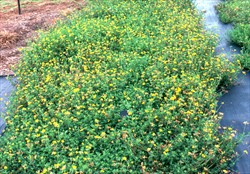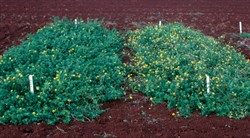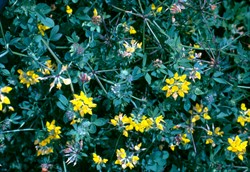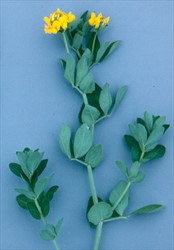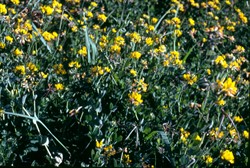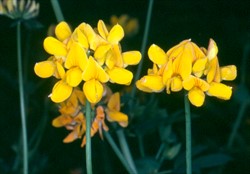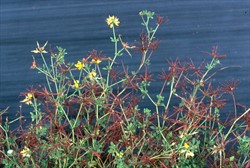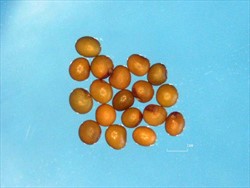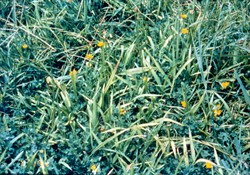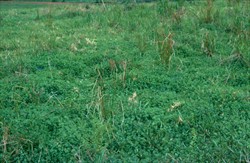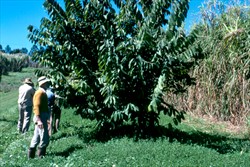Lotus uliginosus
Tropical Forages
Lotus uliginosus Schkuhr
Note: There is considerable confusion in the literature between the closely related and morphologically similar species, Lotus uliginosus Schkuhr and Lotus pedunculatus Cav. ILDIS treats Lotus uliginosus Schkuhr as a synonym of Lotus pedunculatus Cav., while GRIN accepts them as partly sympatric but separate species.
Lotus decumbens Poir.; Lotus nummularius Rchb. ex Steud., nom. nud.; Lotus pedunculatus auct. mult.; Lotus pedunculatus Cav. var. villosus (Lamotte) O. Bolòs & Vigo; Lotus uliginosus Schkuhr var. villosus Lamotte
Family: Fabaceae (alt. Leguminosae) subfamily: Faboideae tribe: Loteae.
Stoloniferous and shallowly rhizomatous perennial with underground crown. Stems herbaceous, hollow, erect or ascending, scrambling, 15‒60 (‒100) cm tall in leniently managed stands, or prostrate, mat forming in intensively managed stands. Leaves glabrous or sparsely pilose to pubescent, pentafoliolate (or trifoliolate with expanded leaf-like stipules); leaflets glaucescent, ovate or obovate, obtuse, 4‒25 mm long and 3‒15 mm wide. Inflorescence umbel-like, comprising 5‒12 (‒15) flowers; corolla 10‒18 mm long, yellow often with reddish veins. Pod slender, cylindric, straight, terete, 15‒40 mm long and 1.5‒2.5 mm broad, dark brown when mature. Seeds spherical, ovoid or reniform, greenish yellow to dark brown, 20‒40 per pod, 0.7‒1.2 mm diameter. 1.2 (tetraploids)‒2 million (diploids) seeds per kg.
Similar species
Lotus uliginosus Schkuhr.: calyx teeth about as long as tube, the upper pair separated by an acute sinus in bud.
Lotus pedunculatus Cav.: calyx teeth longer than tube, the upper pair separated by an obtuse sinus in bud.
Asia: قرن الغزال السبخي (Arabic); ネビキミヤコグサnebiki-miyakogusa (Japanese); лядвенец топяной lâdvenee topânoj (Russian); iri gazal boynuzu (Turkish)
Latin America: alfalfa chilota, lotora (Chile)
English: big trefoil, bog bird's-foot-trefoil, greater bird's-foot trefoil, greater lotus, lotus major, marsh birdsfoot trefoil, stalked birds-foot trefoil
French: bon gueru, grand lotier, lotier des fanges, lotier des marais, lotier pédonculé, lotier velu, pied de pigeon, pied de poule
German: Sumpf-Hornklee, Sumpfschotenklee
Other European: močvarna svinđuša (Croatian); štírovník bažinný (Czech); sump-kællingetand (Danish); moerasrolklaver (Dutch); soo-nõiahammas (Estonian); isomaite (Finnish); sompetôchklaver (Frysk); moscári kerep (Hungarian); loto delle paludi, ginestrino palustre (Italian); dūkstu vanagnadziņš (Latvian); pelkinis garždenis (Lithuanian); fortiriltunge (Norwegian); komonica błotna (Polish); erva-coalheira (Portuguese); cuernecillo grande, loto cenagoso, loto de los pantanos (Spanish); stor käringgigel, stor käringtand (Swedish)
Native :
Africa: Algeria (north); Egypt (north); Libya (north); Morocco; Tunisia
Asia: Turkey
Europe: Albania; Austria; Belgium; Bulgaria; Czech Republic; Denmark; Estonia; France (incl. Corsica); Germany; Greece (incl. Crete); Ireland; Italy (incl. Sardinia); Latvia; Lithuania; Netherlands; Poland; Portugal; Romania; Slovakia; Spain; Sweden; Switzerland; Ukraine (west); United Kingdom
Macaronesia: Madeira Islands (Portugal), Canary Islands (Tenerife, Spain)
Cultivated/naturalized:
Americas: Argentina, Canada, Chile, USA
Australasia: Australia, Finland, Hungary, New Zealand
Indian Ocean: Réunion
Macaronesia: Azores
Pacific Ocean: Hawaii (USA)
Forage
Used as a pasture for cattle and sheep. Suitable for conservation as hay or silage.
Environment
Used as a ground cover under fruit trees and in agroforestry.
Other
Has a role in apiculture for both honey and pollen production.
Soil requirements
Occurs on a wide range of soils from gravelly sands to clays, preferring sands and humic soils. Soil pH at collection sites ranges from 5.5 to 9, and in cultivation, it has grown successfully in soils with levels as low as 4.5. Tolerant of moderate to high levels of available Al and Mn. Although adapted to soils of low pH and low fertility, it responds to increased soil pH and improved fertility.
Moisture
Although annual rainfall in its native environment is as low as 500 mm, L. uliginosus only occurs in wet meadows and woodland, marshes, freshwater margins and ditches. In cultivation, it is usually grown in wet, poorly drained situations or where rainfall exceeds about 1,200 mm/yr, ideally well distributed throughout the year. In more temperate environments, it has been successful at 90‒1,000 mm/yr. Has developed various mechanisms to confer a tolerance of waterlogging superior to that of most forage legumes and can also withstand long periods of surface flooding (not inundation) by fresh or slightly salty water. Damage from flooding is usually greater in the warmer months than in the cooler ones. It is more tolerant of flooding than Vigna parkeri that it overlaps with in its commercial application. Drought tolerance varies with genotype, some only persisting on the edge of flowing streams where there is constant free moisture, while others, such as 'Grasslands Maku', can survive several months in dry soil.
Temperature
Occurs from about 30º N in north Africa to 60º N in Fennoscandia, and at altitudes to 1,500 m asl. This equates to a range in average annual temperatures from (5‒) 10‒17 ºC. Diurnal temperatures frequently fluctuate above and below freezing point; frost is common; but little, if any, lasting snow cover during winter is experienced. Best growth is produced between about 20 and 25 ºC but tolerates much lower and higher temperatures. Lower cool season and better warm season growth than Trifolium repens. Foliage is killed by temperatures below about -5 ºC, but plants mostly recover from crowns and rhizomes. Germination rate and percentage increases above 5 ºC. Normally sown when temperatures exceed about 10 ºC.
In the predominantly summer rainfall subtropics, growth and persistence are very seasonal. Yield and stolon density peak in late spring and then decline to such an extent that early-mid autumn yields can be very low and almost all stolons/rhizomes have died. Stolons/rhizome density improves over winter, increasing in spring, given adequate soil moisture, to start the cycle again.
Light
Grows well in full sunlight, but has moderate shade tolerance, being sown as ground cover in Pinus radiata plantations. Shading by taller grasses is avoided by rapid stem elongation, scrambling over the grass.
Reproductive development
Described as a long-day plant, requiring a daylength of over l6 hours for profuse flowering. This obviously varies with genotype, 'Sharnae' producing initial flowers in September in the subtropics in the southern hemisphere (daylength increasing, 12 hours), and 'Grasslands Maku' in mid-December (daylength increasing, 14 hours). Flowers June, July, August in Europe (daylength 17‒14.5 hours, decreasing). The cultivars used in the subtropics develop a minimal soil seed-bank at best.
Defoliation
Has the ability to grow through taller grasses under lenient grazing management, but, once established, is also adapted to intensive defoliation. Close grazing by sheep over an extended period has not reduced stands. Under this management, dense mats are formed with reduced leaflet size. More tolerant of intensive grazing than Lotus corniculatus. Lax grazing in late summer and autumn encourages rhizome growth and spread, aiding stand persistence. Cut in early bloom for haymaking.
Fire
In the rare event that fire should encroach onto wet areas where L. uliginosus is growing, plants survive by virtue of the buried crowns and rhizomes.
Guidelines for establishment and management of sown forages.
Establishment
Can be established vegetatively using 10‒20 cm long stem sections, planted on a 25‒50 cm grid, or from seed sown at 1‒3 kg/ha. L. uliginosus has a specific inoculum requirement, nodulating on particular strains of the fast growing, acid tolerant Mesorhizobium loti or the slower growing, acid sensitive Bradyrhizobium sp. (Lotus). Higher rates of N-fixation under acid conditions have been recorded from Bradyrhizobium than from Mesorhizobium strains. Strains TAL 43, 187 and 925 (USA), CC 829 or CB 2270 (Australia) and NZP 2309 (New Zealand) are recommended. High levels (>50%) of hard seed are common in manually harvested seed, but commercial seed does not require scarification prior to sowing. Seed is normally broadcast onto a clean, firm seedbed or planted no more than 1 cm deep and rolled. Seed can also be oversown into existing grassland following heavy grazing and trampling to reduce competition for developing seedlings then trampling again post-sowing to encourage soil-seed contact. Successful establishment has been achieved by "dribbling" seed over the wheel of a tractor onto wet soil while traversing the heavily-grazed paddock. Seed is sown in spring in temperate areas, or spring or autumn in warm temperate or subtropical environments. Seedling growth is initially slow.
Fertilizer
Adapted to much lower fertility soils than is the alternative species, Trifolium repens, but responds to occasional applications of phosphorus. As P fertility increases, T. repens tends to become the dominant legume in mixed stands. Lime is not essential in acid soils, but may improve growth if pH is brought up to about 5.5.
Compatibility (with other species)
Forms effective mixtures with tufted and sward-forming grasses, providing an obvious nitrogen impact to companion species. Can coexist with T. repens in warm temperate and subtropical pastures under low to moderate soil fertility. Does not compete well with broad-leafed weeds or aggressive grasses during establishment, but once established, can grow over such species.
Companion species
Grasses: Axonopus fissifolius, Digitaria eriantha (pangola), Festuca arundinacea, Paspalum distichum, Setaria sphacelata var. anceps.
Legumes: Trifolium repens, Vigna parkeri.
Pests and diseases
Various diseases have been identified on L. uliginosus in those countries where it is used, but none is of any real consequence. In the USA, blackpatch disease, summer blight (caused by Rhizoctonia solani) and southern blight (Sclerotium rolfsii) cause blighting of leaves and stems during warm weather. Anthracnose (Colletotrichum truncatum) also causes and leaf and stem blight as well as a leaf spot. Nematodes are not normally a problem in poorly drained soils. However, it appears that 'Sharnae' has resistance to root knot nematode (Meloidogyne spp.), whereas 'Grasslands Maku' is susceptible.
Heavy infestations of lygus bugs (Lygus spp. Heteroptera: Miridae) during flowering cause blossom drop and shrivelled seed, and sometimes almost complete failure of plants to form pods. Other mirids (Calocoris norvegicus Heteroptera: Miridae) as well as aphids sucking on and killing flower buds and heliothis (Helicoverpa armigera) eating developing pods, reduce seed crops if not controlled. Plants are sometimes killed or severely injured by Walshia spp. larvae (Lepidoptera Cosmopterigidae: Walshiidae). Lucerne leaf roller (Merophyas divulsana Lepidoptera: Tortricidae) and Dichomeris ammoxantha (Lepidoptera: Gelechiidae) cause minor damage at times.
Ability to spread
Once established, plants spread fairly rapidly by virtue of stolons and rhizomes, even through relatively dense grass, particularly in low swards. In temperate environments, spread is assisted by natural reseeding and build-up of seed banks. In the subtropics, minimal spread from seed has been noted, and vegetative spread is limited to the ideal moist/wet but not inundated situations. This failure to develop a significant soil seed-bank in the subtropics prevents recovery following disasters (floods, droughts) that eliminate all vegetative material.
Weed potential
Has shown little or no potential for weediness in the subtropics.
Nutritive value
Crude protein levels can be as high as 28% in young growth, declining with age to 20% or less. Similarly, IVOMD declines from >75% to <65%. By contrast, changes in nutritive value of T. repens over the same period are minimal. While the feeding value of L. uliginosus is generally similar to that of Medicago sativa, it has the advantage of not causing bloat. Condensed tannins in the leaves and stems prevent formation of foams during ruminant digestion, thus preventing bloat. They also protect plant proteins in the rumen from degradation, thus allowing more protein to be utilized in the small intestine. On the negative side, condensed tannins can adversely affect voluntary intake and rumen digestion if present in high concentrations in the forage, leading to reduced animal production. Tannin levels vary with soil or growing conditions, and may be as high as 11% of the DM when grown on acid infertile soils, and 2‒3% on fertile soils. Levels of 3‒4% of condensed tannins in the dry matter are a suitable compromise to provide adequate animal performance and confer bloat resistance. This ratio is best achieved when big trefoil is grazed with a companion grass.
Palatability/acceptability
Readily grazed by cattle, sheep, deer, elk, geese, ducks and poultry. Highly acceptable whether at vegetative stage for grazing, or as conserved hay or silage.
Toxicity
No reports of toxicity in L. uliginosus, although toxic cyanogenic glycosides have been recorded in other Lotus spp.
Dry matter
Under ideal conditions, DM yields up to 12 t/ha have been recorded, although yields are more commonly of the order of 3‒8 t/ha DM.
Animal production
Capable of producing 150‒>300 g/day LWG in sheep, which is, on average, 87% of that achievable from T. repens.
Although self-fertile, plants are incapable of spontaneous self-pollination and require pollinators, usually honey bees. Outcrossing also occurs. Natural populations are primarily diploid (2n = 12), although tetraploids have been produced in breeding programs.
Better seed yields are achieved from more open stands, which can be produced using atrazine. Pod numbers and seeds per pod can be increased using the chemical growth regulator, (2-chloroethyl) trimethylammonium chloride (Cyclocel(r)). Crop is cut or grazed to about 10 cm before closing stands off in preparation for flowering. Crops should be irrigable to ensure that stands do not dry out during seed-set and pod-fill. Average seed yields range from about 250 kg/ha for 'Grasslands Maku' to 400 kg/ha for 'Grasslands Sunrise'. 'Sharnae' can produce ±300 kg/ha seed.
Seedlings are susceptible to asulam, benazolin, bentazone, chloropham and MCPB. MCPB, 2,4-DB, and the benazolin types, as well as the selective grass herbicides can be used on mature stands, but not the less-selective herbicides.
- Adapted to acid, infertile soil conditions
- Tolerant of high levels of soil aluminium and manganese
- Adapted to wet or poorly drained soils
- Tolerant of flooding
- Frost tolerant
- Persistent in perennial grass pastures
- Nutritive value compares favourably with that of Medicago sativa
- Does not cause bloat in cattle or sheep
- Moderate shade tolerance (not as shade tolerant as Arachis pintoi ).
- Limited to humid subtropics and upland tropics
- Poor drought tolerance
- Requires specific inoculum
- Low seedling vigour and slow to establish
- Slow regrowth following defoliation
Armstrong, C.S. (1974) 'Grasslands Maku' tetraploid lotus (Lotus pedunculatus Cav). New Zealand Journal of Experimental Agriculture 2:333–336. doi.org/10.1080/03015521.1974.10427691
Barry, T.N. and Duncan S.J. (1984) The role of condensed tannins in the nutritional value of Lotus pedunculatus for sheep: 1. Voluntary intake. British Journal of Nutrition 51:484–491. doi.org/10.1079/BJN19840054
Barry, T.N., Manley, T.R. and Duncan, S.J. (1986) The role of condensed tannins in the nutritional value of Lotus pedunculatus for sheep: 4. Sites of carbohydrate and protein digestion as influenced by dietary reactive tannin concentrations. British Journal of Nutrition 55:123–137. doi.org/10.1079/BJN19860016
Blumenthal, M.J. and McGraw, R.L. (1999) Lotus adaptation, use and management. In: Beuselinck, P.R. (ed) Trefoil: The science and technology of Lotus. CSSA Special Publication 28. Crop Science Society of America (CSSA), Madison, WI. p. 97–119.
Blumenthal, M.J., Aston, S.C. and Pearson, C.J. (1996) Effect of temperature and moisture potential on germination and emergence in Lotus sp. Australian Journal of Agricultural Research 47:1119–1130. doi.org/10.1071/AR9961119
Blumenthal, M.J., Bowman, A.M., Cole, A., Jones R.M., Kelman W.M., Launders T.E. and Nicol, H.I. (1999) Establishment, growth and persistence of greater lotus (Lotus uliginosus ) at six sites in eastern Australia. Australian Journal of Experimental Agriculture 39:819–827. doi.org/10.1071/EA99013
Cooper, J.E., Wood, M. and Bjourson, A.J. (1985) Nodulation of Lotus pedunculatus in acid rooting solution by fast and slow growing rhizobia. Soil Biology & Biochemistry 17:487–492. doi.org/10.1016/0038-0717(85)90015-X
Hare, M.D. (1992) Inter-row and cross-row cultivation, atrazine application and band spraying effects in ‘Grasslands Maku’ lotus (Lotus uliginosus Schk.) seed production. Journal of Applied Seed Production 10:78–83. bit.ly/2vVpY1C
Hare, M.D. and Lucas, R.J. (1984) ‘Grasslands Maku’ lotus [Lotus pedunculatus (Cav.)] seed production. I. Development of Maku lotus seed and determination of time of harvest for maximum seed yields. Journal of Applied Seed Production 2:58–64. bit.ly/2WSEGBQ
Jarvis, B.D.W., Van Berkum, P., Chen, W.X., Nour, S.M., Fernandez, M.P., Cleyet-Marel, J.C. and Gillis, M. (1997) Transfer of Rhizobium loti, Rhizobium huakuii, Rhizobium ciceri, Rhizobium mediterraneum, and Rhizobium tianshanense to Mesorhizobium gen. nov. International Journal of Systematic Bacteriology 47:895–898. doi.org/10.1099/00207713-47-3-895
John, A. and Lancashire, J.A. (1981) Aspects of the feeding and nutritive value of Lotus species. Proceedings of the New Zealand Grassland Association 42:152–159. bit.ly/2Jo4r4M
Schachtman, D.P. and Kelman, W.M. (1991) Potential of Lotus germplasm for the development of salt, aluminium and manganese tolerant pasture plants. Australian Journal of Agricultural Research 42:139–149. doi.org/10.1071/AR9910139
Schiller, K.N. and Ayers, J.F. (1993) The effects of winter conditions on the nutritive value of Lotus pedunculatus cv. Grasslands Maku and Trifolium repens cv. Haifa. Tropical Grasslands 27:43–47. bit.ly/2Jk96EU
Vance C.P., Reibach P.H. and Pankhurst C.E. (1987) Symbiotic properties of Lotus pendunculatus root nodules induced by Rhizobium loti and Bradyrhizobium sp. (Lotus). Physiologia Plantarum 69:435–442. doi.org/10.1111/j.1399-3054.1987.tb09221.x
Waghorn, G.C., Ulyatt, M.J., John, A. and Fisher, M.T. (1987) The effect of condensed tannins on the site of digestion of amino acids and other nutrients in sheep fed on Lotus corniculatus L. British Journal of Nutrition 57:115–126. doi.org/10.1079/BJN19870015
Wedderburn, M.E. and Lowther, W.L. (1985) Factors affecting establishment and spread of 'Grasslands Maku' lotus in tussock grasslands. Proceedings of the New Zealand Grassland Association 46:97–101. bit.ly/2Jk9jYI
'Grasslands Maku' Released in New Zealand (1975). Induced tetraploid (2n = 24) developed from crosses between naturalized New Zealand material and a winter-growing Portuguese line. Widely adapted, from about 44.5º S in the uplands of the South Island of New Zealand to near sea level at 26º S and 17.5º S at 1,000 m asl in Australia, providing moisture is adequate. Resistant to grass grub (Costelytra zealandica Coleoptera: Scarabaeidae) and porina caterpillar (Wiseana spp. Lepidoptera: Hepialidae).
'Grasslands Sunrise' Released in New Zealand (1991). Diploid (2n = 12) from the above breeding program. Smaller leaved, with a denser, more prostrate growth habit than 'Grasslands Maku'; with improved autumn growth, more persistent and productive under continuous grazing.
'Grasslands Trojan' Released in New Zealand (2003). Tetraploid, selected for improved establishment vigour compared with 'Maku'.
'Sharnae' (CPI 67677) Released in New South Wales, Australia (1991). Diploid, origin Algarve, southern Portugal, (37.2º N, 8.5º W, 350 m asl, rainfall 850 mm). Less cold tolerant than 'Grasslands Maku' and 'Grasslands Sunrise'. Morphologically similar to 'Grasslands Maku', but less hairy, with smaller seeds and more seeds/pod. Flowers about 3 months earlier in the subtropics.
'Beaver', 'Columbia', 'Kaiser' and 'Marshfield' are cultivars in Oregon, Washington and Indiana, USA.
SA 12952 Identified in WA, Australia. From Tunisia. Flowers about 1 week later than 'Sharnae', and produces higher seed yields. Dry matter yields are at least 2.5 times those of 'Sharnae' or 'Grasslands Maku' in the Mediterranean environment in WA. Not tested in the summer rainfall subtropics.
